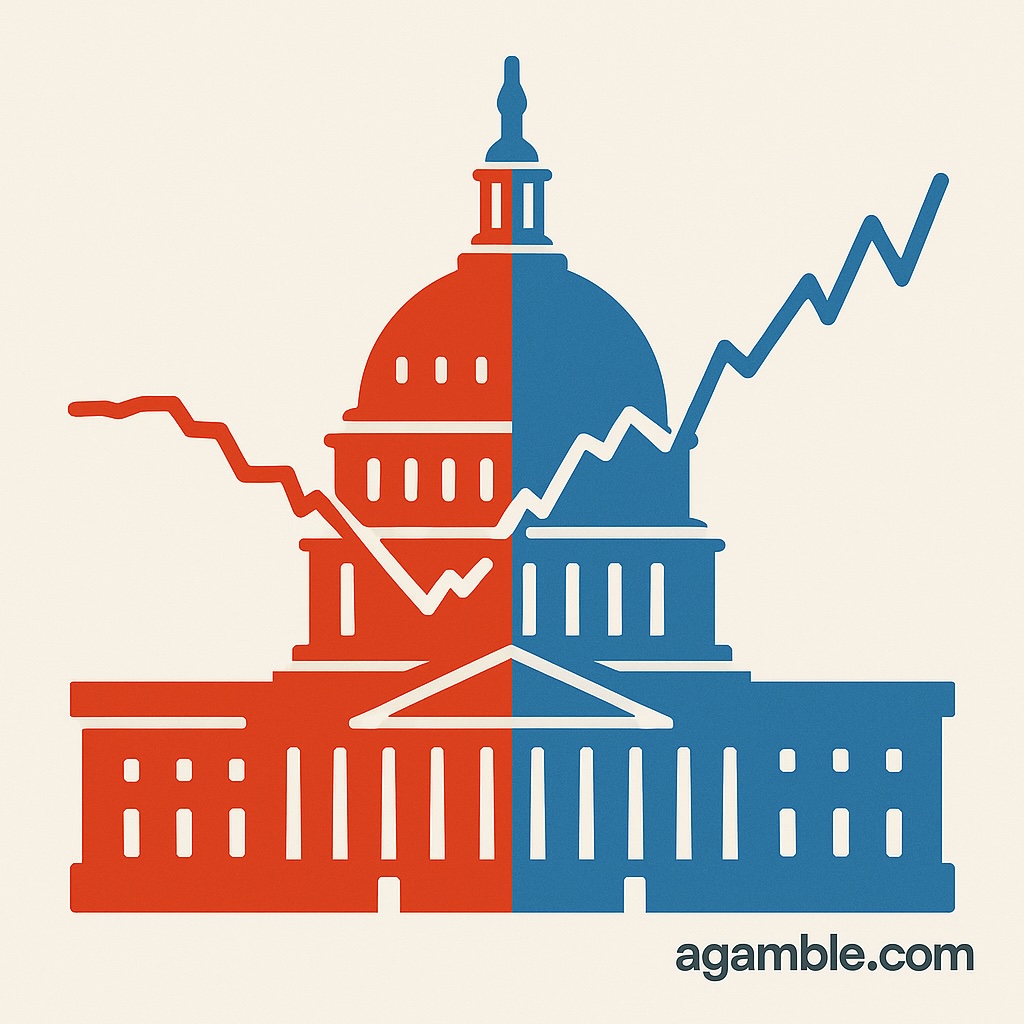Prediction markets on Polymarket currently see a divided Congress as the most likely outcome of the 2026 U.S. midterms, according to agamble.com’s analysis. As 2026 midterms odds continue to react to President Donald Trump’s early endorsements and aggressive affordability messaging, traders are weighing how much his involvement could reshape the balance of power.
The leading contract — Republican Senate, Democratic House — trades at 48%, while a Democratic sweep of both chambers sits at 30% and a Republican sweep at 19%. With more than $790,000 already traded on the Balance of Power market and over $640,000 on a separate House-control market, traders are steadily their forecasts on who will control Washington.

What the 2026 Balance of Power Odds Show Right Now
The Balance of Power market is a combined forecast for which party will control the Senate and the House of Representatives after the 2026 midterms. In simple terms, traders are betting on one of four basic outcomes:
- Democrats control both chambers (Democratic sweep).
- Republicans control both chambers (Republican sweep).
- Republicans hold the Senate while Democrats hold the House.
- Democrats hold the Senate while Republicans hold the House.
“Control” is defined by who holds a voting majority in each chamber, including the vice president’s tie-breaking vote in the Senate. If there is any ambiguity—say, a few independents or unresolved races—the market resolves based on who becomes the first Speaker of the House and Senate Majority Leader after the election. Major news outlets like the Associated Press, Fox News, and NBC serve as the resolution sources.
In that sense, this prediction market is a compact way to track how traders think the entire federal legislative map will look once the 2026 votes are counted and the dust settles.
Where the 2026 Midterms Map Stands Today
On Polymarket’s Balance of Power board, Republican Senate / Democratic House leads at 48%. That reflects a view that the GOP has a structural edge in the Senate map, while Democrats are better positioned to capture or retain the House.
A Democratic sweep of both chambers trades at 30%, down slightly in recent days. This outcome would require Democrats to win competitive Senate seats while also securing a House majority — a scenario that would dramatically constrain President Donald Trump’s second-term agenda and re-open the possibility of impeachment proceedings.
The Republican sweep contract, where the GOP holds both chambers, sits at 19%. Traders see this as possible but clearly less likely than a split government, especially given Trump’s slipping approval ratings and historical patterns of midterm losses for the president’s party.
A Democratic Senate / Republican House outcome is priced as a longshot at around 2%, reflecting how rarely traders expect Republicans to hold the more volatile House while losing ground in the Senate.
House Control: Democrats Now Clear Favorites
Polymarket’s dedicated market on “Which party will win the House in 2026?” reinforces the Balance of Power signal. Democrats trade at 74%, while Republicans sit at 27%. That pricing is broadly consistent with the combined Balance of Power contracts, where all scenarios that feature a Democratic House (Dem sweep plus R Senate/D House) sum to roughly three-quarters of total probability.
Kalshi’s “How many House seats will Republicans hold after the Midterms?” market adds another layer. The most active ranges cluster between the low 210s and low 220s, with bands like 213–217 and 218–222 drawing significant volume. Since 218 seats are needed for a majority, traders are effectively saying Republicans are likely to land near the line — but more often just below it than clearly above.
Taken together, these markets suggest a House that tilts Democratic but remains competitive, with narrow margins and a real possibility of tight procedural fights in the next Congress.
How Trump’s Strategy Fits Into the Forecast
The markets are also reacting to a highly unusual political backdrop. President Trump is far more involved in 2026 midterm strategy than most sitting presidents, pressing Republican incumbents to stay in their seats, endorsing dozens of candidates early, and pushing a message focused on affordability and tax cuts.
At the same time, his approval ratings have slid into the high 30s amid voter frustration over inflation and living costs. Historically, unpopular presidents tend to cost their parties seats in Congress, a risk traders appear to be pricing into the odds for House control even as Republicans work to build a Senate “firewall” against Democratic investigations and potential impeachment.
In other words, the prediction market view reflects both sides of the equation: an aggressive, hands-on president trying to protect his majorities, and an electorate that remains skeptical about the economy.
So Who Wins the Midterms? 2026 Predictions at a Glance
Right now, the markets point to a split Congress as the baseline forecast: Republicans favored in the Senate, Democrats favored in the House. A Democratic sweep remains a substantial possibility at around 30%, while a full Republican sweep is treated as a longer-odds outcome under 20%. The dedicated House markets on Polymarket and Kalshi broadly confirm this picture, clustering around a narrow Democratic advantage built on small shifts in key suburban and swing districts.
As more polling, fundraising data, and candidate decisions surface over the next year, traders expect the nearly $1.4 million already wagered across these midterm markets to grow significantly — and the odds to sharpen. For now, though, the prediction markets see 2026 shaping up not as a wave for either party, but as a closely fought battle for marginal control.
Would you bet?
Follow the “Balance of Power: 2026 Midterms” prediction market here: https://polymarket.com/event/balance-of-power-2026-midterms




